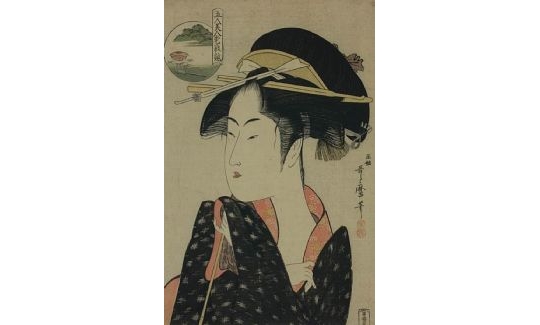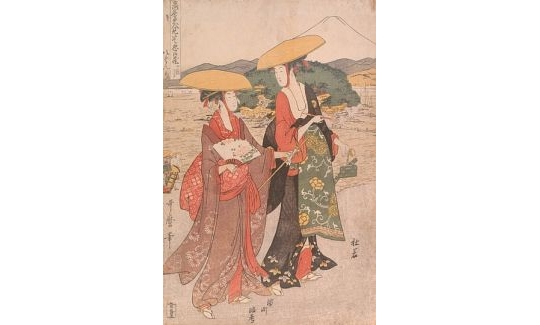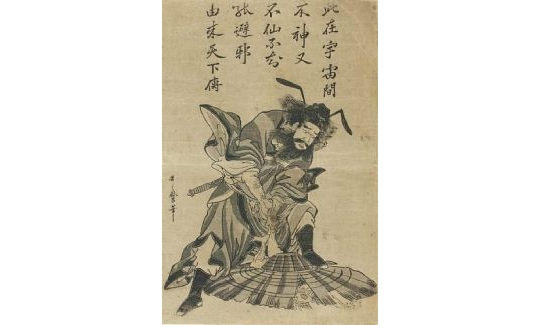Kitagawa Utamaro (1753-1806), who died just 200 years ago, was one of the most productive and creative artists of the ukiyo-e ("pictures from the floating world") school. He is famous principally for his woodblock prints and his paintings of beautiful women (bijin-ga) in the teahouses, shops and pleasure quarters of Edo (today Tokyo). In his youth he studied art for a short while with Toriyama Sekien (1712-1788) of the Kano school, who painted in various styles.
Utamaro's first set of prints appeared in the early 1770s in popular books and guides (kibyoshi) to the Kabuki Theatre, published essentially for the Theatre's patrons. Towards the end of the 18th century he also began designing individual prints of Kabuki actors in the style of Katsukawa Shunsho (1726-1792). He signed these prints "Toyoaki". In ca. 1782 he took the name Utamaro, and his great talent is evident in his prints from this period.
At the close of the 18th century Utamaro created compositions for diptychs, triptychs, and other combinations, of figures in landscapes or inside houses. He also created some of the finest illustrated books in the history of ukiyo-e, including "The Insect Book" (Ehon mushi erami, 1788), "The Mad Monk on the Moon" (Kyogetsudo, 1789), and "The Silver World" (Ginsekai, 1790).
Utamaro's diptychs and triptychs from the end of the Temmei period (Temmei; 1781-1789) and the early Kansei period (Kansei; 1789-1801) are examples of his mature ability to design prints of figures in compositions that are spread over several sheets. In the prints from the Temmei period, even though the influence of his contemporary/ Torii Kiyonaga (1752-1815) is very marked, and in most of the pages from the beginning of the Kansei period, it is obvious that he developed a more stylish, personal line, in which groups of people are depicted in more realistic compositions. Another of his methods of achieving an intimate relationship between the spectator and the painted subject was to place a figure in the forefront of the picture.
Apart from these, Utamaro's best-known designs are the single prints of the Kansei period. They are usually vertical, in standard oban size (appr. 25x38 cms,). In the 1790s he created either complete or partial figures, and portraits. These usually consisted of groups of three, and sometimes four or five, individuals or couples.
Utamaro's prints of girls from the teahouses and pleasure quarters are perhaps the finest ukiyo-e works of all time. They are examples of the most perfect expression of female beauty in Japanese art, and Utamaro's reputation derives from them. A distinctive component of his conceptualization of the pleasure girls is his depiction of them in their own milieu. His artistic originality derives from his constant observation of the daily activities of these women. He focused on the personal, intimate elements of their lives that, to the untrained eye, seem so attractive and fine, but were actually very hard. His prints thus provide us with a reliable documentation of the activities of the pleasure quarters, legal and illegal, more or less exclusive, that flourished in the big cities.
Utamaro's intention of depicting figures with exactitude is evident in the portrait prints (okubi-e), "close-ups" in which specific features that convey personality are emphasized to underline the situation in which the subject finds him/herself. Utamaro also created realistic portrait prints, such as those of Naniwaya Okita, Takashimaya Ohisa, Tomimono Toyohina, and Ogiya Hanaogi. In these, specific characteristics are eemphasized - in the line of the nose, the fullness of the cheeks, or the delicate outline of the eyes. Nonetheless, his portraits do not aspire to absolute realism. Utamaro was always interested in idealizations of female beauty, emphasizing the traits that embody femininity and disregarding any elements that might detract from it. His women are presented in attitudes that best display their elegance and refinement. Another important element of the prints is that the women are from all strata of society, including the pleasure quarters, so that, idealization not withstanding, he also wanted to convince us of the reality of his subjects. He tried to express their emotions, ultimately producing a series of prints illustrating "Selected Love Songs" in which he examines various aspects of love's positive and negative qualities.
Kitagawa Utamaro created prints for several publishers, but was most closely connected with Tsutaya Junzaburo (1750-1797), who published a great many of them. Tsutaya was the best-known publisher in Edo at that time, and contributed much to the success of the ukiyo-e artists and popular authors. Working with him guaranteed Utamaro that the prints would be faithful to his original sketches, and printed to the highest degree of excellence because the carvers and printers who worked for Tsutaya were certainly among the most proficient of the period. Utamaro lived with Tsutaya in the late 1770s, and was sometimes influenced by other artists who worked with him, such as Torii Kiyonaga.
The prints from the beginning of the 19th century return to the formulae of standard compositions, and only a few works from those years have any originality. Perhaps this is because Utamaro's pupils were involved in the making of them. In 1804, he was imprisoned for creating a picture of the military governor Toyotomi Hideyoshi
(1537-1598) in, according to the authorities, an unsuitable style. Although his imprisonment was of short duration, he became depressed, and this affected his work. Kitagawa Utamaro died two years later at the age of fifty-four.



